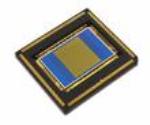Two new papers are to be presented stressing the fundamental CMOS Image Sensor (CIS) Technology at San Diego’s SPIE annual meeting this week. The first paper to be initiated by Dr. Brian Rodricks on Tuesday, deals with the effects of emission damage on scientific CMOS (sCMOS) due to exposure to protons and high X rays.
The second paper on Fairchild Imaging’s L3CIS’s (Low Light Level CMOS Image Sensors) night vision performance would be presented by Dr. Boyd Fowler after two days.
 Fairchild Imaging sCMOS image sensor
Fairchild Imaging sCMOS image sensor
CMOS Sensors are created keeping in mind the needs of scientific imaging. Attributes such as Total Ionizing Dose (TID) hardness and SEE (single event effects) would be experimented on, by exposing the sensor to 50 kRads of 50kVp X-ray and 150 kRads of 10 MeV proton radiations. The results indicate an increase in the Dark Current and also higher radiation hardness, when compared to the currently used CCD Image Sensors, but did not demonstrate any symptom of equipment collapse. According to Rodricks, in future, this innovative technology could be used in x-ray and aerospace application because of the dynamic range, high resolution, sensitivity and speed of sCMOS together, with its high radiation tolerance levels.
CIS Technology, which is the basis of Fairchild imaging, is now being used for night vision imaging. A 5.5 mega pixel L3CIS system having dark current levels which are lower than 4picoamps/Sq cm and a read noise level that is less than two electrons will be demonstrated by Dr. Fowler. The imaging activity stretches to include starlight conditions, due to the sensor’s well developed sensitivity, along with other features such as its 100 frames/sec readout and 90 decibel dynamic range. Thus the L3CIS’s extraordinary performance fused with an Infrared sensor contributes to a High-end night vision imaging product.